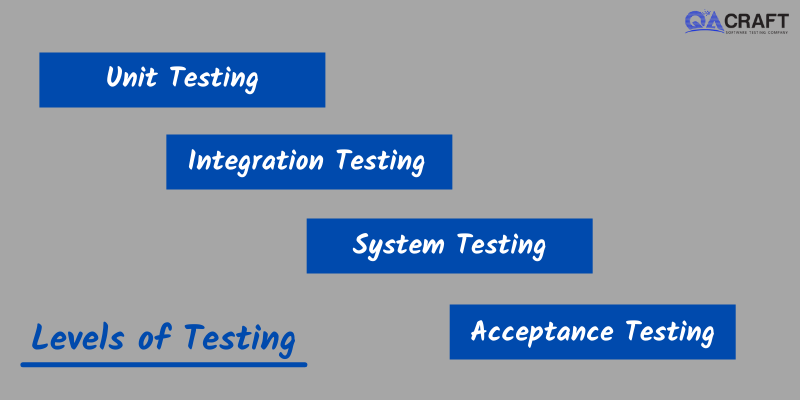The goal of levels of testing is to organise, streamline, and make it simple to locate all potential test cases and test scenarios at a specific level. There are various steps in the SDLC paradigm, including requirement gathering, analysis, coding, design, execution, testing, and deployment. All of these stages involve various testing levels while testing software.
For software testing, a variety of testing levels are employed or used to assist in monitoring actions and performance. These testing levels were re-coded and re-linked amongst the development lifecycle states to fill in any gaps.
Levels of Testing in Software Testing
Unit testing, system testing, integration testing, and acceptance testing are the four main testing tiers in software testing.
- Unit Testing
- Integration Testing
- System Testing
- Acceptance Testing

Each level of testing is crucial for software testing, but these four levels are particularly crucial for software engineering.
Unit Testing
This type of testing, which is carried out by the developer, examines a single component or unit in software testing.
Functional testing’s foundational stage is also known as unit testing. Validating the functionality of unit components is the main objective of unit testing.
The fundamental objective of testing each individual component or unit is to ensure that it is right in terms of fulfilling requirements and having the necessary functionality. A unit is the smallest testable piece of a system or application.
The key benefit of this testing is that by finding any software issues early in the day, the team decreased the risks associated with software development and the time and money lost on having to go back and fix fundamental flaws in the program once it was almost finished.
Integration Testing
Integration testing involves integrating several software modules and testing phases to see if the integrated system is prepared for system testing or not. There are numerous techniques to evaluate how various system components interact with one another.
Integrity testing, which identifies the data flow from one module to another, is carried out by testers.
System Testing
System testing is most likely the last test to determine whether the system satisfies the requirements and criteria, and it assesses both functional and non-functional testing requirements.
System testing makes it possible to verify that the system complies with the specifications, and all of the software’s components are tested collectively to make sure that the final product does as well. Testing for load, resiliency, performance and security is required.
System testing is a crucial step since the software is almost ready for market production and can be tested in a setting that is extremely similar to the market and user-friendly settings that the user will experience.
Acceptance Testing
Acceptance testing’s objective is to determine whether the system satisfies end-user requirements and whether it is prepared for deployment.
The tester will use a different approach, such as pre-written scenarios and test cases, to test the software. The results from these tools will be used to find ways to improve the system, and the QA team or testing team can find out how the product will function when it is installed on the user’s system.
Acceptance testing includes everything from simple typos and grammatical errors to serious flaws that could result in a critical issue in the program.
Other Types of Testing:
- Regression testing
- Alpha testing
- Beta testing
- Pair/Buddy testing
Conclusion:
- Before the program or software is released, completion of each level of testing is required. You could want to look into the different kinds of software testing in the interim to verify the most crucial details.
- It is recommended to test periodically and as soon as feasible.
- The tester can find any systemic flaws as soon as possible, saving time and money later on, by adopting a constant vigilance and checking viewpoint in all your projects and by using a systemised approach to testing.
Check out all the software testing webinars and eBooks here on EuroSTARHuddle.com
